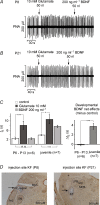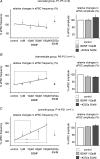Developmental changes in brain-derived neurotrophic factor-mediated modulations of synaptic activities in the pontine Kölliker-Fuse nucleus of the rat
- PMID: 17569735
- PMCID: PMC2277243
- DOI: 10.1113/jphysiol.2007.134726
Developmental changes in brain-derived neurotrophic factor-mediated modulations of synaptic activities in the pontine Kölliker-Fuse nucleus of the rat
Abstract
The Kölliker-Fuse nucleus (KF), part of the respiratory network, is involved in the modulation of respiratory phase durations in response to peripheral and central afferent inputs. The KF is immature at birth. Developmental changes in its physiological and anatomical properties have yet to be investigated. Since brain-derived neurotrophic factor (BDNF) is of major importance for the maturation of neuronal networks, we investigated its effects on developmental changes in the KF on different postnatal days (neonatal, P1-5; intermediate, P6-13; juvenile, P14-21) by analysing single neurones in the in vitro slice preparation and network activities in the perfused brainstem preparation in situ. The BDNF had only weak effects on the frequency of mixed excitatory and inhibitory spontaneous postsynaptic currents (sPSCs) in neonatal slice preparations. Postnatally, in the intermediate and juvenile age groups, a significant augmentation of the sPSC frequency was observed in the presence of 100 pm BDNF (+23.5+/-12.6 and +76.7+/-28.4%, respectively). Subsequent analyses of BDNF effects on evoked excitatory postsynaptic currents (eEPSCs) revealed significant enhancement of eEPSC amplitude of +20.8+/-7.0% only in juvenile stages (intermediates, -13.2+/-4.8%). On the network level, significant modulation of phrenic nerve activity following BDNF microinjection into the KF was also observed only in juveniles. The data suggest that KF neurones are subject to BDNF-mediated fast synaptic modulation after completion of postnatal maturation. After maturation, BDNF contributes to modulation of fast excitatory neurotransmission in respiratory-related KF neurones. This may be important for network plasticity associated with the processing of afferent information.
Figures








Similar articles
-
Developmental changes in the BDNF-induced modulation of inhibitory synaptic transmission in the Kölliker-Fuse nucleus of rat.Eur J Neurosci. 2007 Dec;26(12):3449-57. doi: 10.1111/j.1460-9568.2007.05960.x. Epub 2007 Dec 4. Eur J Neurosci. 2007. PMID: 18052976
-
Emergence of brain-derived neurotrophic factor-induced postsynaptic potentiation of NMDA currents during the postnatal maturation of the Kolliker-Fuse nucleus of rat.J Physiol. 2008 May 1;586(9):2331-43. doi: 10.1113/jphysiol.2007.148916. Epub 2008 Mar 13. J Physiol. 2008. PMID: 18339694 Free PMC article.
-
Impaired transmission at corticothalamic excitatory inputs and intrathalamic GABAergic synapses in the ventrobasal thalamus of heterozygous BDNF knockout mice.Neuroscience. 2012 Oct 11;222:215-27. doi: 10.1016/j.neuroscience.2012.07.005. Epub 2012 Jul 13. Neuroscience. 2012. PMID: 22796079
-
Development of adaptive behaviour of the respiratory network: implications for the pontine Kolliker-Fuse nucleus.Respir Physiol Neurobiol. 2004 Nov 15;143(2-3):155-65. doi: 10.1016/j.resp.2004.04.015. Respir Physiol Neurobiol. 2004. PMID: 15519552 Review.
-
Postnatal emergence of synaptic plasticity associated with dynamic adaptation of the respiratory motor pattern.Respir Physiol Neurobiol. 2008 Dec 10;164(1-2):72-9. doi: 10.1016/j.resp.2008.06.013. Respir Physiol Neurobiol. 2008. PMID: 18620081 Review.
Cited by
-
A New Theory to Explain the Underlying Pathogenetic Mechanism of Sudden Infant Death Syndrome.Front Neurol. 2015 Oct 19;6:220. doi: 10.3389/fneur.2015.00220. eCollection 2015. Front Neurol. 2015. PMID: 26539157 Free PMC article. Review.
-
Breathing disorders in Rett syndrome: progressive neurochemical dysfunction in the respiratory network after birth.Respir Physiol Neurobiol. 2009 Aug 31;168(1-2):101-8. doi: 10.1016/j.resp.2009.04.017. Epub 2009 Apr 24. Respir Physiol Neurobiol. 2009. PMID: 19394452 Free PMC article. Review.
-
Learning to breathe: control of the inspiratory-expiratory phase transition shifts from sensory- to central-dominated during postnatal development in rats.J Physiol. 2009 Oct 15;587(Pt 20):4931-48. doi: 10.1113/jphysiol.2009.174599. Epub 2009 Aug 24. J Physiol. 2009. PMID: 19703965 Free PMC article.
-
Reduced levels of brain-derived neurotrophic factor contribute to synaptic imbalance during the critical period of respiratory development in rats.Eur J Neurosci. 2014 Jul;40(1):2183-95. doi: 10.1111/ejn.12568. Epub 2014 Mar 26. Eur J Neurosci. 2014. PMID: 24666389 Free PMC article.
-
Disruption of the brain-derived neurotrophic factor (BDNF) immunoreactivity in the human Kölliker-Fuse nucleus in victims of unexplained fetal and infant death.Front Hum Neurosci. 2014 Sep 4;8:648. doi: 10.3389/fnhum.2014.00648. eCollection 2014. Front Hum Neurosci. 2014. PMID: 25237300 Free PMC article.
References
-
- Alheid GF, Milsom WK, McCrimmon DR. Pontine influences on breathing: an overview. Respir Physiol Neurobiol. 2004;143:105–114. - PubMed
-
- Aoki C, Wu K, Elste A, Len G, Lin S, McAuliffe G, Black IB. Localization of brain-derived neurotrophic factor and TrkB receptors to postsynaptic densities of adult rat cerebral cortex. J Neurosci Res. 2000;59:454–463. - PubMed
-
- Arvanian VL, Mendell LM. Acute modulation of synaptic transmission to motoneurons by BDNF in the neonatal rat spinal cord. Eur J Neurosci. 2001a;14:1800–1808. - PubMed
-
- Arvanian VL, Mendell LM. Removal of NMDA receptor Mg2+ block extends the action of neurotrophin-3 on synaptic transmission in neonatal rat motoneurons. J Neurophysiol. 2001b;86:123–129. - PubMed
-
- Baker-Herman TL, Fuller DD, Bavis RW, Zabka AG, Golder FJ, Doperalski NJ, Johnson RA, Watters JJ, Mitchell GS. BDNF is necessary and sufficient for spinal respiratory plasticity following intermittent hypoxia. Nat Neurosci. 2004;7:48–55. - PubMed
Publication types
MeSH terms
Substances
LinkOut - more resources
Full Text Sources
Research Materials

